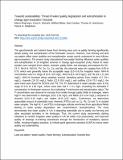| dc.description.abstract | The agrochemicals and nutrient losses from farming areas such as paddy farming significantly dictate quality and eutrophication of the freshwater resource. However, how farming and land use pattern affect water qualities and eutrophication remain poorly understood in most African agro-ecosystems. The present study characterized how paddy farming influences water qualities and eutrophication in 10 irrigation schemes in Usangu agro-ecosystem (UA). About 42 water samples were sampled from intakes, channels, paddy fields, and drainages and analyzed for EC, Cl, P, NH4-N, NO3-N, TN, Zn, Cu, Ca, and Mg. We observed water pH ranging from 4.89 to 6.76, which was generally below the acceptable range (6.5–8.4) for irrigation water. NH4-N concentration was in a range of 10.6–70.0 mg/L, NO3-N (8.4–33.9 mg/L), and TN (19.1–21,104 mg/L). NH4-N increased along sampling transect (sampling points) from intakes (5.7–29.1 mg/L), channels (19–20 mg/L), fields (12.9–35.8 mg/L), and outflow (10.6–70.0 mg/L), the same trend were found for NO3-N and TN. The TP determined in water samples were in the range of 0.01 to 1.65 mg/L; where some sites had P > 0.1 mg/L exceeding the allowable P concentration in freshwater resource, thus indicating P enrichment and eutrophication status. The P concentration was observed to increase from intake through paddy fields to drainages, where high P was determined in drainages (0.02–1.65 mg/L) and fields (0.0–0.54 mg/L) compared to channels (0.01–0.13 mg/L) and intakes (0.01–0.04 mg/L). Furthermore, we determined appreciable amount of potentially toxic elements (PTEs) such as Cu, Pb, Cd and Cr in studied water samples. The high N, P, and PTEs in drainages indicate enrichment from agricultural fields leading to water quality degradation and contaminations (eutrophication). The study demonstrates that water quality in UA is degrading potentially due to paddy rice farming and other associated activities in the landscape. Thus, the current study recommends starting initiatives to monitor irrigation water quality in UA for better crop productivity, and improved quality of drainage re-entering downstream through the introduction of mandatory riparian buffer, revising irrigation practices, to include good agronomic practices (GAP) to ensure water quality and sustainability. | en_US |

